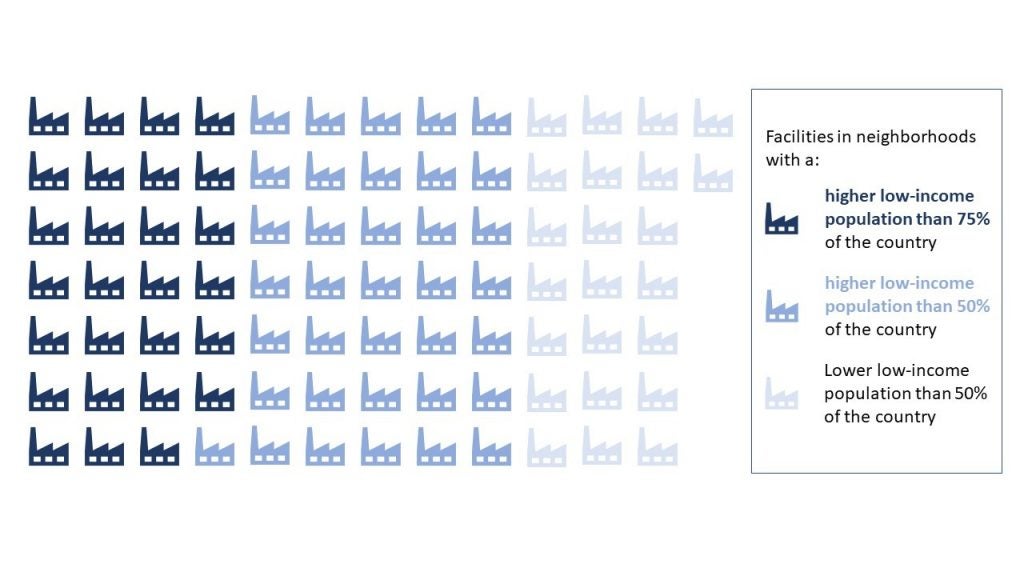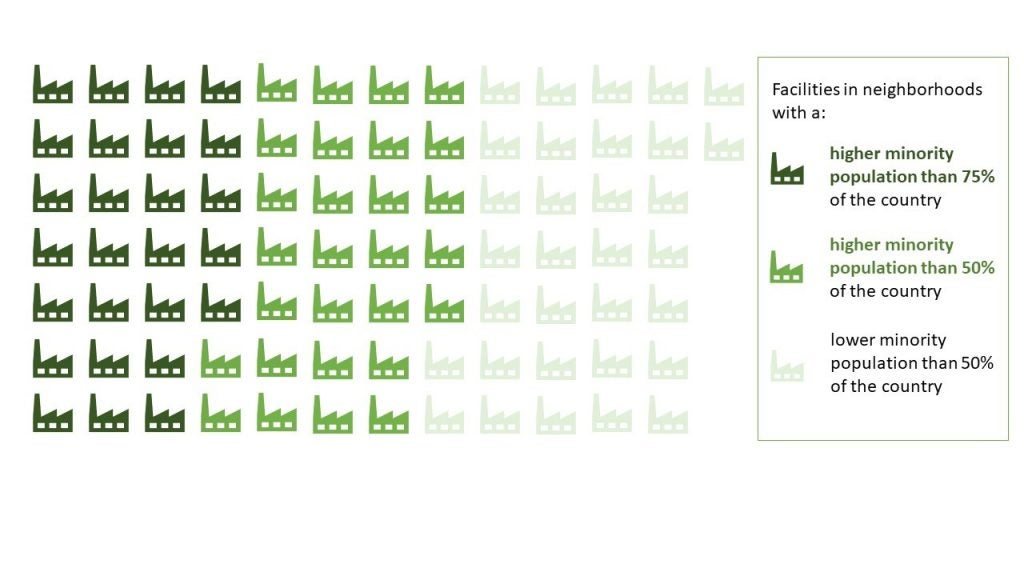The Trump administration’s air toxics loophole would intensify environmental injustice
(Some statistics in this post were corrected on June 24, 2021)
One of the most disturbing aspects of the new coronavirus crisis is that people already struggling with underlying respiratory conditions seem to be at greater risk. This means that vulnerable communities already bearing the brunt of the health harms from dangerous pollution may suffer even more.
Yet the Trump administration has spent the last few weeks racing to roll back policies that safeguard the air we breathe. These rollbacks often impact vulnerable communities the most as well.
One such roll back is the proposed air toxics loophole, which would allow thousands of large industrial facilities nationwide to evade pollution controls and emit more toxic air pollution. In a previous post, we presented analysis of EPA’s own data indicating that the loophole could lead to an increase in emissions of hazardous air pollutants like benzene and mercury by over 49 million pounds across 48 states. We’ve now done further analysis and found that the facilities likely to increase toxic air pollution under this loophole are disproportionately located in vulnerable communities – leading to increased exposure to these dangerous pollutants for heavily minority and low-income neighborhoods.
The proposed air toxics loophole would undermine clean air safeguards for industrial facilities that are currently subject to stringent standards for the emission of mercury, benzene, and other hazardous air pollutants that may cause cancer and other serious health effects. EPA data released with last summer’s proposal identified nearly 4,000 facilities across the US eligible to take advantage of this loophole and increase their emissions of dangerous pollutants.
Of these nearly 4,000, more than 2,500 facilities currently have low enough emissions that EPA predicts they would be likely to take advantage of the loophole. Location and emissions data are available for 1,586 of these facilities.
These facilities span dozens of different source categories, from ethylene production (the first step in making plastics) to oil and gas production. As part of its analysis of this rule, EPA selected three source categories to analyze in greater detail. Of the 592 eligible facilities in these three categories (representing just over 20 percent of the total eligible facilities), EPA predicted that 86 would increase toxic air pollution. While there will almost certainly be significantly more facilities that increase emissions of toxic air pollution – more likely in the thousands – the data available for these 86 facilities provides an important basis for the preliminary analysis of environmental justice impacts.
Collectively, EPA estimated that these 86 facilities alone could increase hazardous air pollution by as much as 2.4 million pounds per year under the proposed loophole. But a closer look at these facilities shows that these unacceptable increases in air toxics would also fall hardest on communities that are already suffering the greatest burdens from air pollution. For each of the 86 industrial sources from the EPA analysis, EDF matched the facility address to neighborhood-level demographic data and found that:
- 73% of the facilities are in census blocks where the percent of the population qualifying as low income is above the national median
- 63% of the facilities are in census blocks where the percent of minority population is above the national median
- 62% of the facilities are in census blocks where the percent of the population above 64 years of age is above the national median
 While the air toxics loophole will affect people across the US – there are eligible facilities in 48 states – some communities are particularly vulnerable to the loophole:
While the air toxics loophole will affect people across the US – there are eligible facilities in 48 states – some communities are particularly vulnerable to the loophole:
Brownsville, Texas
Brownsville is a city of 175,000 located on the western Gulf Coast in South Texas, just over the border from Matamoros, Mexico. The city has one of the highest poverty rates in the nation, and over 90 percent of the residents are Hispanic or Latino. Two of the facilities on EPA’s short list of those with the potential to increase emissions are in Brownsville. The neighborhoods in which these facilities operate are 99 percent minority residents, higher than 97 percent of the country, and 65-to-72 percent low-income, higher than 90-to-94 percent of the country. The two facilities are in the organic liquids distribution source category. According to EPA, the most prevalent toxics from these operations are toluene, hexane, methanol, xylenes, and benzene, which have been shown to have a wide range of cancer-causing and other adverse health effects. Tens of thousands of residents in the area already have respiratory illnesses including asthma and COPD, meaning that an increase in toxic air pollution could seriously compound existing health problems.
Spartanburg, South Carolina
Spartanburg is a city of just over 37,000 residents in northern South Carolina. Spartanburg has a history of industry, and became a center of textile manufacturing in the late 1800’s. Today Spartanburg is home to many large companies, including a textile manufacturer and chemical production facilities. Almost 30 percent of families in Spartanburg fall below the poverty line. Three of the facilities for which EPA projects an increase in toxic air pollution are in Spartanburg, and two of those facilities are in neighborhoods with a higher low-income population than 68 percent of the country, as well as a higher minority population than 73 percent of the country. As in Brownsville, these Spartanburg facilities are all in the organic liquids distribution source category, with some of the most prevalent air toxics including toluene, methanol, and benzene. Spartanburg already struggles with high levels of smog and about 20 percent of people in the county suffer from asthma, COPD, and cardiovascular disease. An increase in toxic air pollution could severely exacerbate existing health problems.
Louisville, Kentucky
With a population of around 600,000, Louisville is the largest city in Kentucky. Two of the facilities on the EPA list are in Louisville. While the city as a whole is just over 25 percent minority, both facilities are located in census blocks with a population over 60 percent minority – greater than 74 percent of the country. These neighborhoods also have a higher low-income population than 58 percent of the country. One of the facilities falls into the organic liquids distribution category, while the other is in the hydrochloric acid production category. Louisville also has incredibly high levels of smog, well above safe levels, and almost 30 percent of residents in the surrounding county suffer from asthma, COPD, or cardiovascular disease. An increase in toxic air pollution in the area could exacerbate an already severe health burden.
These snapshots capture just a fraction of the devastating and disproportionate impacts that the proposed air toxics loophole would have. Many individuals in the communities that would be most affected by the loophole already struggle with underlying respiratory complications that could be exacerbated, creating even greater susceptibility to viruses such as the one causing America’s current crisis. EPA has a responsibility to consider environmental justice and health impacts, and the environmental injustice that would be caused by this loophole shows a clear failure to do so.













